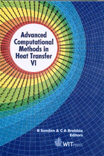A Computational Method To Design Heat Sinks
Price
Free (open access)
Transaction
Volume
27
Pages
10
Published
2000
Size
317 kb
Paper DOI
10.2495/HT000521
Copyright
WIT Press
Author(s)
J.A. Visser
Abstract
A computational method to design heat sinks J.A. Visser Department of Mechanical and Aeronautical Engineering, University of Pretoria, Pretoria, 0002, South Africa Abstract A computationally economical method for the design of aluminum heat sinks is presented. The motivation for this project arose from a growing need in the electronics industry to find efficient ways of improving the design of heat sinks. A three-dimensional finite-difference simulation using curvilinear boundary fitted grids is used to model the conduction heat transfer in the heat sink. Analytical and empirical models for the boundary conditions take into account the effects of natural or forced convection, as well as radiation to the surroundings. Flow bypass is included in the analysis for forced convection. The solution methodology enables solution times of less than 30 seconds for most heat sink geometries. The quick analysis and accurate results verified by experimentation indicate that the
Keywords





